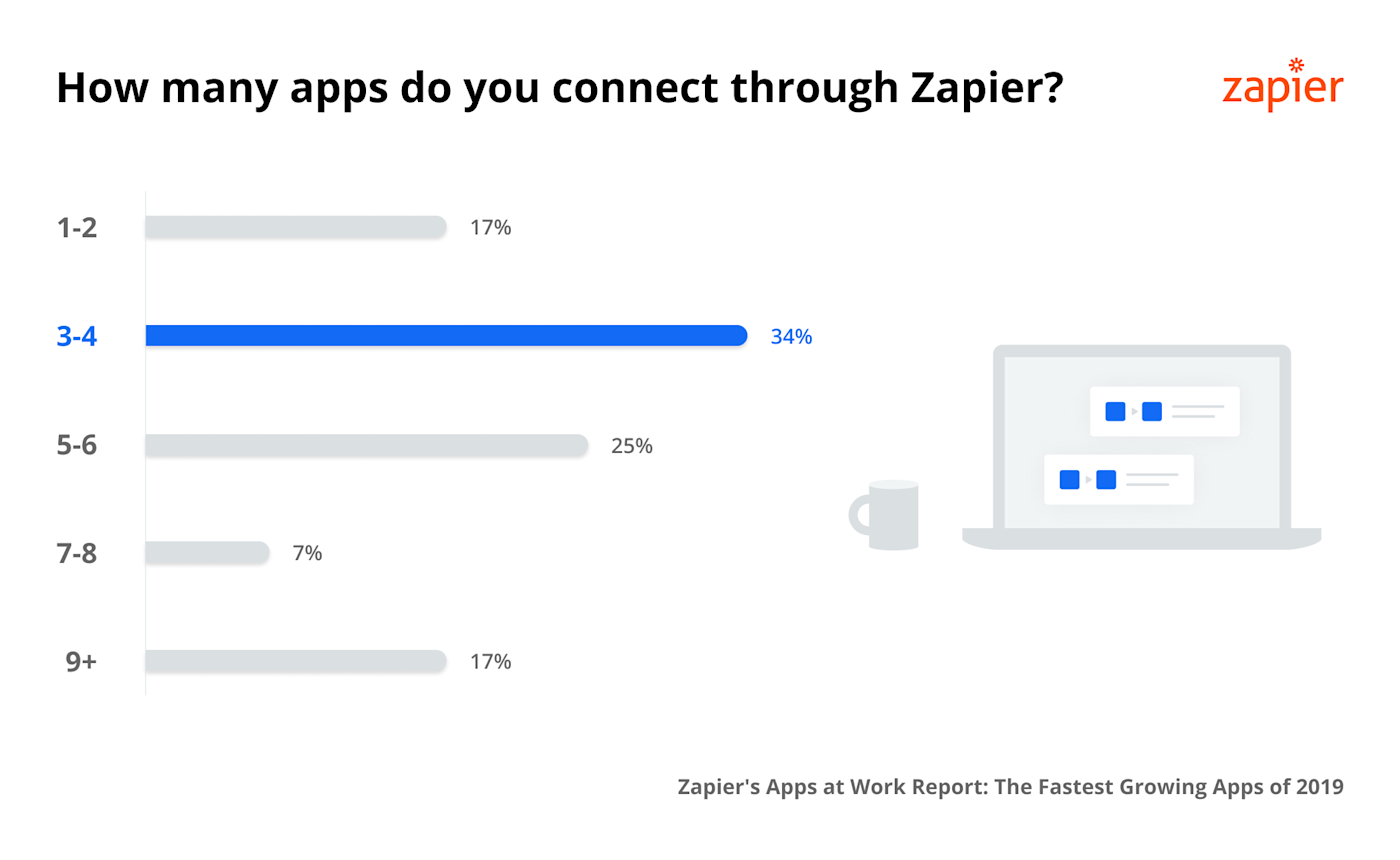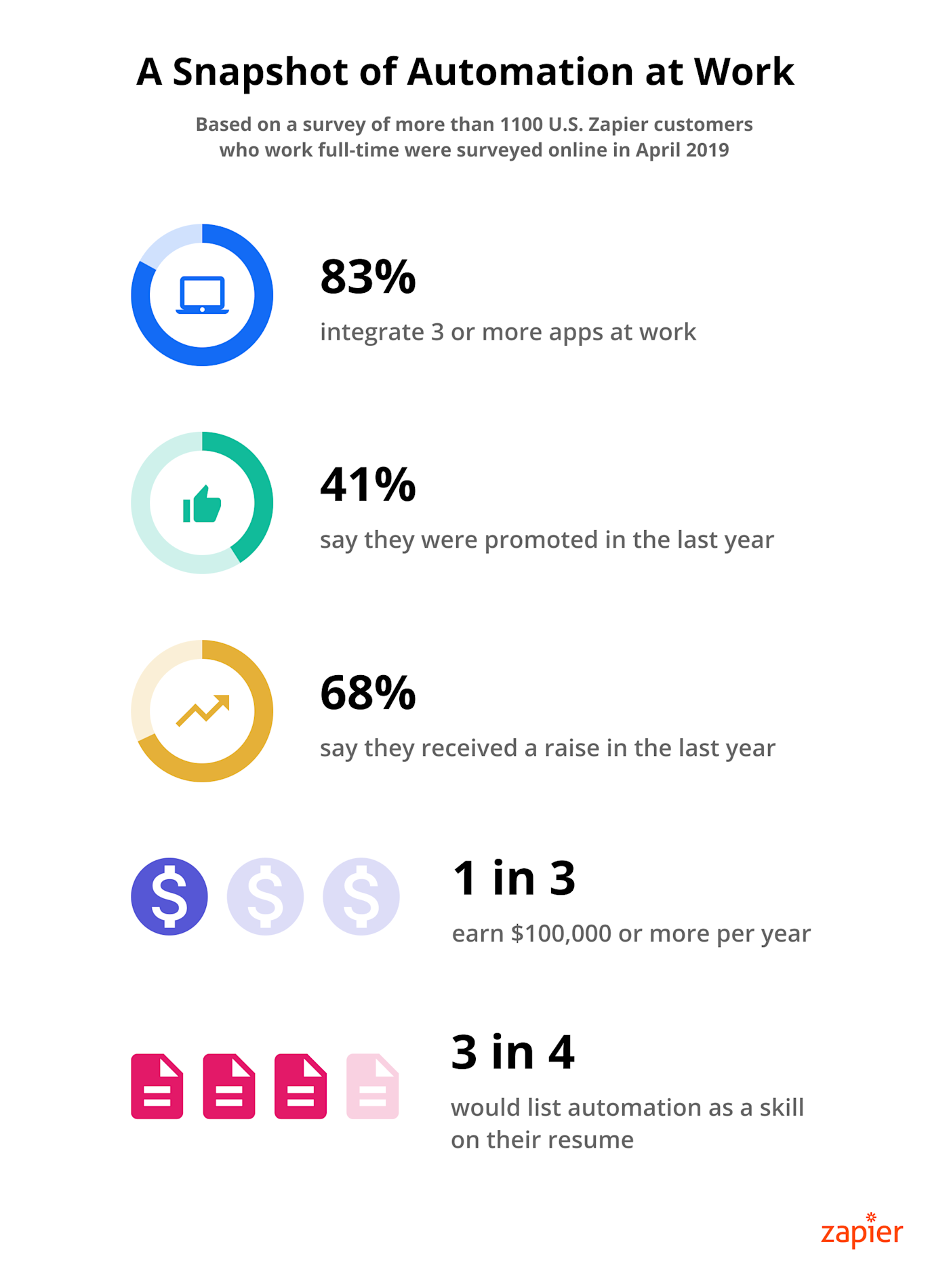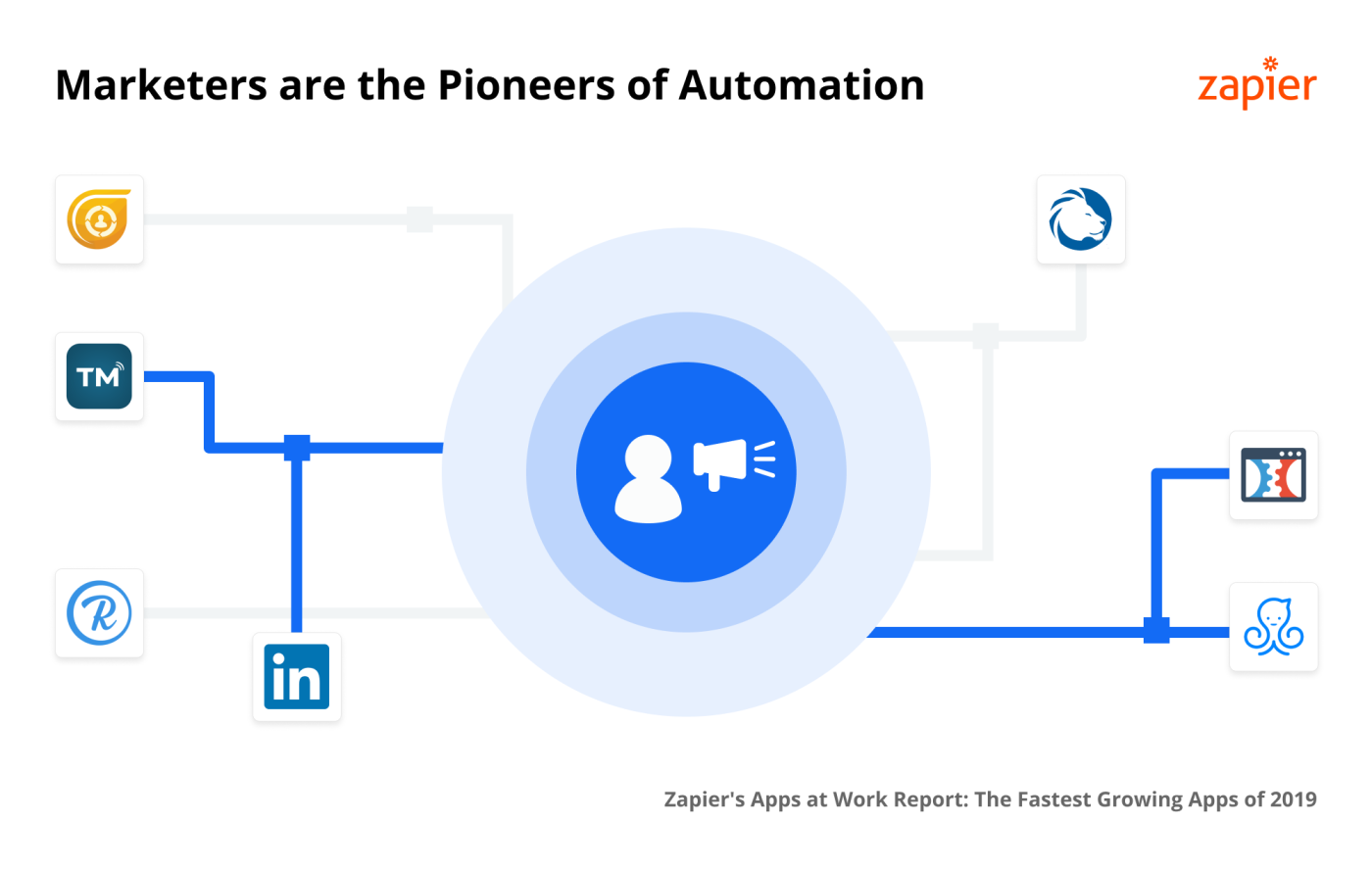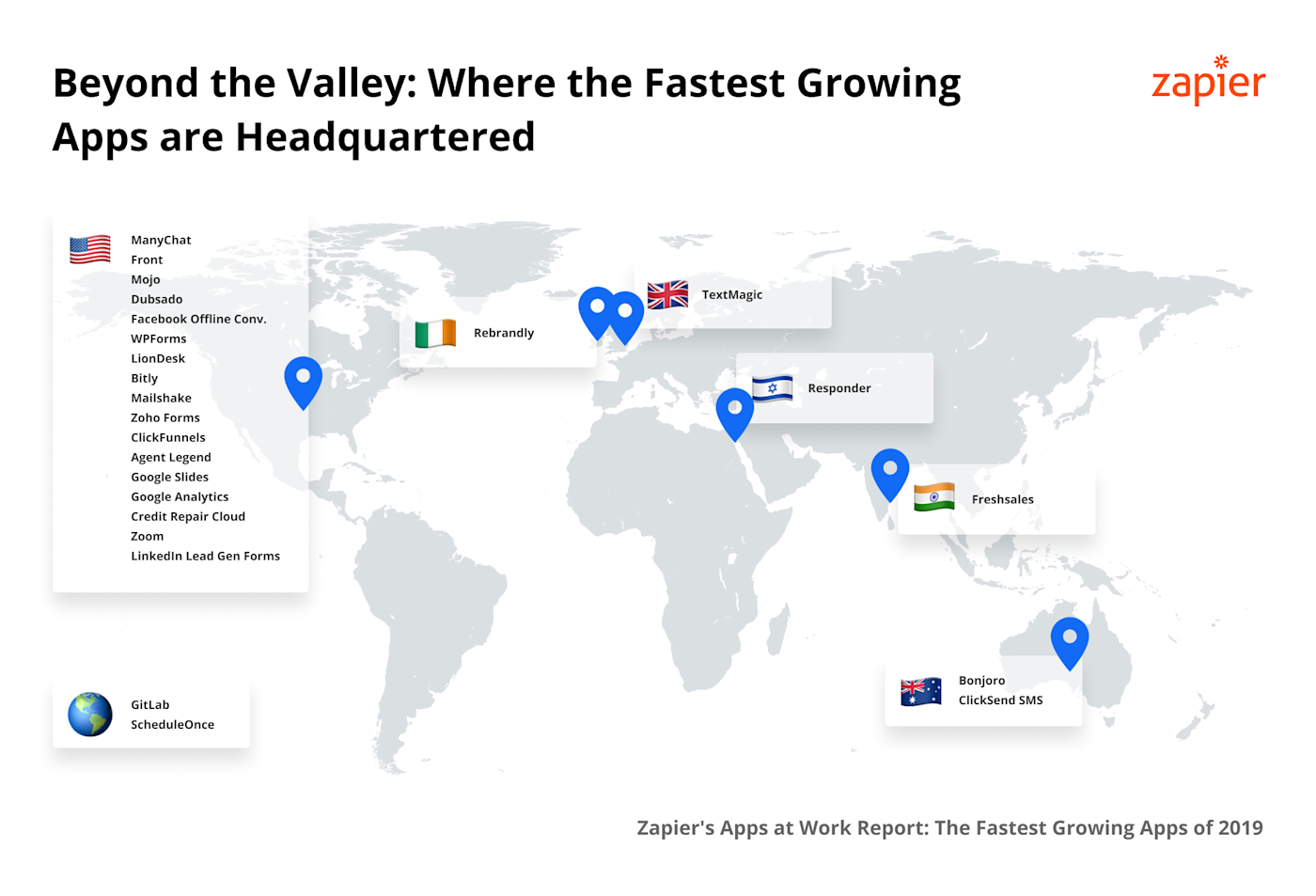Work changes. The skills that got you here may not get you to the next level of your career, and the next role you take may have not even existed a decade ago. That's why using new apps—especially those designed specifically for your industry—is so important. It's your best way to be more productive, level up your skills, and work at a higher level than before.
Zapier's unique position as the connector between over 1,500 of the most popular business apps lets us see the early software trends from some of today's most productive workers. These are the people adopting focused apps that help them achieve more in less time. To create this report, we analyzed the usage of over four million users across thousands of apps, to determine which apps are growing the fastest and the trends they show.

There's an App For Every Task
When apps don't have to be everything to everyone, they can be much better at specific things. Pinterest, a social network for pictures, and Zoom, a video call app were among this year's largest IPOs. Where it didn't make sense in the past to make an app for the smallest possible market, the internet today turns every tiny vertical into a massive audience.
ManyChat, this year's fastest growing app, doesn't need to be a full-featured customer communication suite like older customer support apps would have been. Instead, it's focused on its core Facebook Messenger chatbot features, making them best-in-class for that specific use case. ManyChat's customers still want to send emails to customers—but they already have apps for that, and some of the most popular ManyChat integrations on Zapier include those to automatically add contacts to Mailchimp and ActiveCampaign. That makes even single-purpose apps more versatile than they would be on their own.
Alongside those are the industry-focused apps, including Mojo, LionDesk, and Dubsado—among others. They're focused on specific industries—real estate for the first two, creatives for the latter—and are customized specifically for their needs. They don't need everyone to use them; they instead rely on being the very best for some people's needs and getting as many of those users as possible.
You Can Pick Your Own Apps
It starts with discovery. Software used to be handed down from on high, selected by IT departments and rolled out to the entire company.
Today, when you need a new tool for a task, a new app is a quick search away. Bring your own device led to bring your own apps. It's easy to find the precise apps you need, apps that bring you joy.
That's how today's fastest growing apps enter the workplace. Slack and Zoom both entered the workplace quietly, as people used them on their own. They worked so well that quickly everyone wanted to use them, and they spread virally throughout the team. It's the consumerization of IT, where you pick the apps that work best for your needs instead of waiting for software to be rolled out company-wide. Apps like these are disrupting legacy providers with low NPS scores, and grow fast with a better product designed for users' needs.
So imagine a marketer who wants to make sure their emails get opened, and they discover Bonjoro, an email marketing app built around video. It's a tool marketing and support teams love—but few others would need. Yet it solved a need no one knew they had so well, it's the 10th fastest growing app this year. Odds are, you'd receive a video email, think "Wow, what a great idea," then add Bonjoro to your marketing workflow, too.
Or perhaps a marketer needs to know if their social media posts are driving sales. They need a tool to replace Google's now-shuttered URL shortener, so switch to Bitly, a link shortening tool that's our 9th fastest growing app, which lets you share branded links then analyze which links get the most clicks. They don't need the whole team to use it—they just need that app for a specific task unique to their role.
Localization plays a part, too. Where yesterday's software needed everyone to use it, today apps can win by being the very best for a particular language or region. Responder, for instance, is a fast-growing email marketing app—and it's focused solely on the Hebrew language market. Those same dynamics let apps from around the world compete head-on with the best of Silicon Valley, as five of this year's fastest growing apps have headquarters outside the United States—and two are built by global, distributed teams.
Apps Should Work Together

The core reason to use legacy software is compatibility. An older word processor may not have the latest features, but everyone—from your advisor to your accountant—could open its files. That benefit used to be worth putting up with sub-par software.
The web and APIs (application programming interfaces, the language apps use to talk with each other) changed that. When your email app could import contacts from any spreadsheet file, or anyone could preview your designs in a browser, or your to-dos could be copied over to your team's project management app automatically with tools like Zapier, suddenly it didn't matter what apps everyone used.
Integrations made us stop worrying and love the new apps. Lots of new apps, in fact: When we recently surveyed Zapier users, we found that half of them regularly use five or more apps, and over 17% use nine or more apps. We're not using one software suite for everything—we're switching between apps and relying on integrations to ensure data is where we need it.
Such integrations let WPForms—a tool to build forms inside WordPress sites, and our 7th fastest growing app—build a great tool to gather data without needing to worry about how people will use that data. They also let apps like Front, a shared inbox tool and our 2nd fastest growing app, bring everything together in one place, with your team's emails, SMS messages, live chat, and social media messages in one inbox. They didn't need to build all of those tools—they only needed to make an app that connected everything.
GitLab, our 5th fastest growing app, offers a wide range of tools in one product to help development teams code, collaborate, and continuously iterate on their projects. To do so, though, it too needs integrations to watch your site for issues, pull in bugs from other apps, and work with your in-house development tools. It also needs integrations between its own tools, as some of the most popular GitLab Zapier integrations come from teams automating tasks inside GitLab.
Who's Using the Apps?

Everyone uses apps today—and today's most effective workers lean heavily on apps and automation to do their best work. Of the 1,100 U.S.-based Zapier customers we surveyed this year, over 83% connect three or more apps at work, and 17% use nine or more apps. That's why in today's world, competency in automation is a critical job skill, something over 76% of Zapier users surveyed would list on their resumes.
Software automation is increasingly becoming a marketable skill that's crucial for some of today's best careers, too. Of the people we surveyed, 41% were promoted in the last year, 68% received a raise, and a third of the respondents earn $100,000 or more each year. It's professionals in growing careers who today are looking for new apps and automations that help them achieve more with their time.

Not all industries use apps equally, though. With automation, marketers have long been at the forefront of connecting apps to do more together. From sending customized emails to contacts and automatically sharing new blog posts to social networks, today's marketers are using increasingly specialized, niche apps to help do their jobs better.
Today's fastest growing apps help marketers send personalized messages on Facebook Messenger with ManyChat, track if their marketing worked in the real world with Facebook Offline Conversions, track stats on any links with Bitly, send video emails with Bonjoro, build great outreach emails with Mailshake, and much more. They're leading the wave of new apps focused on automating work.

Real estate agents aren't far behind. They often work individually or in small firms and need to maximize their resources and work as efficiently as possible. As such, they're part of another industry that is quick to adopt automation and new focused apps for their jobs—and there's a growing subcategory of apps catering to their needs.
Along with the marketing apps that could be equally well suited to promoting properties, real estate agents today can use Mojo for a customer relationship management (CRM)-powered phone sales system or LionDesk to help focus their marketing with a CRM designed around real estate sales. They can schedule appointments better with ScheduleOnce, send automated messages with Agent Legend, and stay in touch with clients via SMS messages from TextMagic.
2019's Fastest Growing Apps
The best apps for everyone are different—and this year's Fastest Growing Apps list highlights that, with apps for a wide range of industries and needs. If you want to work more productively in 2019, these are the apps you should consider using:
ManyChat: Chatbots, for Facebook Messenger.
Front: Collaborative email app, for teams.
Mojo: CRM and online phone, for real estate.
Dubsado: Business management, for creatives.
GitLab: Every development tool, in one app.
Facebook Offline Conversions: Online analytics, for the real world.
WPForms: Forms, for your WordPress blog.
LionDesk: Marketing CRM, for real estate.
Bitly: Analytics, for everything you share.
Bonjoro: Email, but with video.
Mailshake: Email templates, for outreach messages.
Zoho Forms: Forms, built around integrations.
ScheduleOnce: Appointment scheduling, for booking-focused businesses.
ClickFunnels: Landing pages, for sales and marketing funnels.
Agent Legend: Automated messaging, for real estate.
Freshsales: CRM, with built-in phone and email.
Google Slides: Collaborative presentations, in your browser.
Google Analytics: Detailed stats for your website and apps.
TextMagic: Automated SMS messages with team SMS chat.
Credit Repair Cloud: CRM, for mortgage brokers.
ClickSend SMS: Communications however you need them, via email, SMS, fax, voice messages, and paper mail.
Responder (רב מסר): Email marketing, for the Hebrew-speaking market.
Zoom: Video calls that reliably work on any internet connection.
LinkedIn Lead Gen Forms: Ads with pre-filled forms.
Rebrandly: Links, that can be rerouted and branded.

Methodology
For the past three years, Zapier has published annual reports about the fastest growing apps on our platform. Zapier's Apps at Work: Fastest Growing Apps 2019 Report focuses on growth among apps on Zapier’s platform between April 1, 2018 and March 31, 2019. To be eligible, apps must have an active, public Zapier integration and are weighed using Zapier's proprietary algorithm. Usage from trial and employee accounts are excluded.


